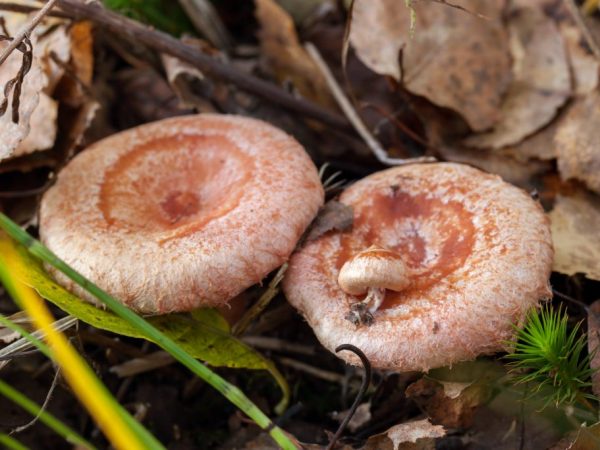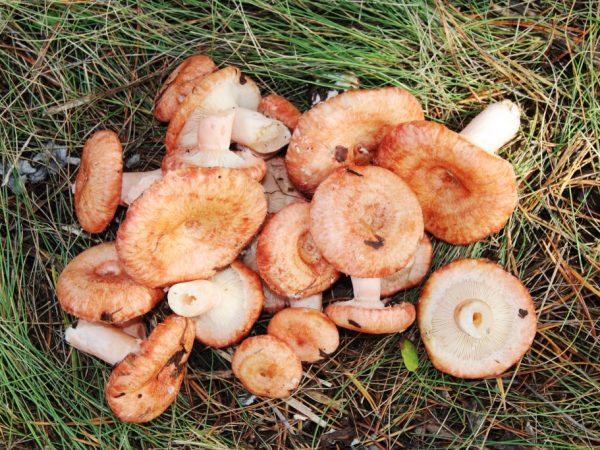Conditionally edible mushroom pink
The pink mushroom belongs to the genus Mlechnik, included in the russula family of the Agaricomycetes class. Belongs to the department of Basidiomycetes.

Conditionally edible mushroom pink
Botanical characteristic
According to the botanical description, the pink wave has a mushroom cap that grows in diameter up to 4-12 cm, in rare cases - up to 15 cm. Initially, the cap has a convex appearance, eventually becomes flat. In the central part of it, a small depression is formed in adult mushrooms.
The edges of the mushroom cap are pubescent, bent towards the stem. The surface is covered with a thick layer of coarse villi that form irregular concentric circles. The skin on the mushroom cap is slimy. The color is pale pink, sometimes with a gray tint, also ranging from yellow-orange to light beige. In the absence of rainy weather, the color of the pink wave changes to almost white (fades). With mechanical action on the surface, the mushroom cap acquires a dark shade.
The pink wave, or Lactarius torminosus, also has popular names: rubella, volnyanka, krasul, volzhanka, etc. Many are related to the word “wave”, since the surface of the mushroom cap is similar to ripples on the water surface.
The mushroom pulp is white. Its structure is dense and strong. The fruiting body has a pungent taste. It emits a white milky juice with a sharp taste and an interesting resinous smell, abundant, does not change color when in contact with air.
The mushroom leg is pale pink, its height is 3-6 cm, width is 1-2 cm, the shape of a regular cylinder, slightly tapers towards the base. The structure is quite strong and solid. In young mushrooms, the cavity at the stem is absent, but as the fungus grows, it becomes empty (hollow). The surface is covered with fluff, sometimes small depressions (pits) are present.
No matter how strange it may sound, the presence of caustic milky juice does not scare off parasites. Pink Volnushka is one of the most worm-eaten mushrooms.
Mushroom plates - hymenophores, are colored milky, closer to white, a pink tint is also permissible. They are often planted, have intermediate plates (small, located between them), not wide, descending along the mushroom leg. With age, the color of the mushroom plates changes to yellowish.
Geography of distribution
Places of growth of pink waves cover the northern parts of the forest zone. It can be found in birch or birch-mixed forests. They appear in areas well-lit by the sun in grassy thickets, and are less common in humid areas. The species is mycorrhizal. Representatives of the species are able to form a symbiotic association of mycelium with birch roots, mainly of old trees.
The active growth season occurs in the second half of June and lasts until the end of October. Mass fruiting of pink wolfberry is observed in 2 stages: initially in the last days of July and again in the first days of September.
Similar varieties

The wave has no poisonous counterparts
The pink wave in nature has similar edible and conditionally edible varieties, including:
- Lactarius spinosulus, or thorny milky: which is characterized by the absence of terry pubescence at the edges of the mushroom cap. They are smooth and even in this species. The mushroom is conditionally edible, good for eating in a salted form.
- Lactarius pubescens, or white wave: has a less contrasting color of the mushroom cap is almost white, while the mushrooms themselves are smaller. The diameter of the cap of the white wave is slightly smaller than that of the pink wave.
- Lactarius deterrimus, or spruce mushroom and L. deliciosus, or R. present: have a milky sap colored bright orange. It is released when the mushroom pulp is mechanically damaged.
Practical use
In terms of food quality characteristics, the pink volnushka belongs to category 2. It is a conditionally edible mushroom. Acceptable for use salted and pickled, in some dishes - fresh.
Irina Selyutina (Biologist):
In spite of the unique biochemical composition, the pink wolf in the countries of Western Europe is ranked among the harmful and inedible mushrooms. There they are rigidly positioned as poisonous mushrooms, which are strictly prohibited for consumption. The famous French mycologist writer Gerard Houdu considers this mushroom poisonous. In his book “Mushrooms. Encyclopedia ”published in Russia in 2003, he claims that the pink wave has toxic properties and its use in food is impossible due to the occurrence of intestinal disorders. However, the practice of Finland and the Russian Federation shows that in many Russian regions and on the territory of Finland, the pink wave is the leader of home preparations for the winter.
Before being used for food, these mushrooms are subject to prolonged soaking and short-term heat treatment with boiling water or steam (blanching). During the cooking process, the mushrooms turn yellow.
When salting, small mushrooms are especially appreciated, the diameter of which does not exceed 3-4 cm. People call them "curls".
Inhabitants of the center and south of Europe do not use volnyanka for food purposes, in Finland it is fried after 5-10 minutes of blanching.
A weakly boiled pink wave is mildly poisonous and can cause irritating mucous reactions, as well as bowel upset. In salted form, the pink wave becomes edible and ready for use 50 days after salting.
Conclusion
The pink wave belongs to the milkmen from the russula family. It is conditionally edible. In terms of nutritional and taste qualities, it is applicable for culinary purposes after soaking and heat treatment. This species is one of the main mushrooms harvested for the winter in the northern regions of Russia.



